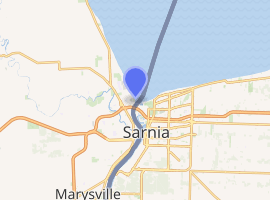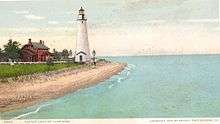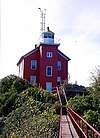Fort Gratiot Light
Fort Gratiot Light, the first lighthouse in the state of Michigan, was constructed north of Fort Gratiot in 1829 by Lucius Lyon, who later became one of Michigan's first U.S. Senators.[10]
.jpg) | |
 | |

| |
| Location | Omar and Garfield Sts., Port Huron, Michigan |
|---|---|
| Coordinates | 43°0′22.7″N 82°25′20.9″W |
| Year first constructed | 1825 |
| Year first lit | 1825 |
| Automated | 1933 |
| Foundation | Dressed stone and timber[1] |
| Construction | Brick |
| Tower shape | Frustum of a cone attached to workroom[2] |
| Markings / pattern | White |
| Tower height | 85 feet (26 m)[3] |
| Focal height | 82 feet (25 m)[4] |
| Original lens | Fourth-order Fresnel lens |
| Current lens | DCB-224 Carlisle & Finch Aerobeacon |
| Range | 18 nautical miles (33 km; 21 mi) |
| Characteristic | Fl green 6 seconds[5] |
| Fog signal | Station will give available information on fog conditions in upper river by radiotelephone when requested, (156.80 MHz). Standby light of reduced intensity lighted throughout 24 hours.[6] |
| ARLHS number | USA-291[7][8] |
| USCG number | 7-10015 |
| Heritage | place listed on the National Register of Historic Places, Michigan state historic site |
Fort Gratiot Lighthouse | |
 Undated USCG image | |
| Area | less than one acre |
| Architect | Lyon, Lucius; Moors, J. |
| NRHP reference No. | 76001975[9] |
| Added to NRHP | July 30, 1976 |
The Fort Gratiot Light marks the entrance to the St. Clair River from Lake Huron (going south) in the southern portion of Michigan's Thumb. The light is still active and the grounds are an active Coast Guard facility, but it has recently been handed over to the Port Huron Museum. It is the oldest surviving lighthouse in Michigan. There is also a public beach and park on the property, known as Lighthouse Beach.
It is across the river from Point Edward Front Range Light.[11]
History
With the completion of the Erie Canal, traffic in the Great Lakes increased dramatically. Coal was being brought from Michigan, stone (and more timber) was being brought from Wisconsin and the entrance to the St. Clair River became a bottleneck. In 1823, Congress appropriated $3,500 to construct a light in "Michigan Territory" near Fort Gratiot.

The contract for construction of the lighthouse and keeper's dwelling was awarded to Captain Winslow Lewis of Massachusetts. Lewis was the inventor of the patented Lewis lamp, which the Fifth Auditor had universally adopted as the primary source of illumination in the nation's growing inventory of lighthouses. A staunch supporter and ally of the Fifth Auditor, Lewis had branched out into the business of lighthouse construction, and as the frequent low bidder, was being awarded a growing number of contracts to fulfill the nation's need for navigational aids on the East Coast.
Lewis sub-contracted the construction of the tower and keeper's dwelling that would become known as the "Fort Gratiot Light" to Daniel Warren of Rochester, New York. Work commenced on the structure, but appears to have been running far beyond the scope of the original bid, since Congress appropriated an additional $5,000 for the project's completion on April 2, 1825.[12]
Even with the major cost overrun, it became quickly apparent that the structure was both poorly designed and constructed. George McDougall, a former Detroit lawyer of some ill repute was selected as the light's first official keeper. McDougall's reports indicated that the stairs were so steep that they had to be climbed sideways, and the trapdoor into the lantern room was barely large enough for a man to squeeze through. While McDougall no doubt reported with truth on this situation, he was reputedly a short man with a weight in excess of 300 pounds, and as such hired an assistant to perform all of his tower work.[12]
Originally the tower was 32 feet (9.8 m) tall. In 1861, after two additions, the tower reached its current height of 82 feet (25 m).[13][14]
McDougall's concerns were supported when the tower was damaged during a storm in the fall of 1828, and later fell down. Congress reacted swiftly and appropriated $8,000 for a new tower in 1829. The new tower was 65 feet tall and 25' in diameter and it was outfitted with the Lewis lamp system (powered by whale oil) that was then the standard.
Soon after its establishment in 1852, the new US Lighthouse Board determined that the Lewis lamps universally accepted by the prior Pleasonton administration were significantly inferior to the French Fresnel lenses being adopted throughout the rest of the world. After conducting successful trials of the new lenses in a few East Coast lights, the Board decided to upgrade all lenses throughout the system. As a result, the Lewis lamps were removed from Fort Gratiot in 1857, and the tower was refitted with a fourth-order Fresnel lens, which had an intensity at least four times that of the old Lewis lamps.[12]
In 1874, a brick duplex keeper's house was built.[15]
As lake shipping continued to rise dramatically in the early second half of the century, it was determined that the Fort Gratiot Light needed further upgrading. To this end, in 1862 the government increased the height of the tower to 82 feet (25 m), and the fourth-order Fresnel was replaced with a larger third-order lens, showing a fixed white light. The old fourth-order lens was taken to Saginaw and installed in the Saginaw River Lighthouse.[12]
The fog signal building was added in 1900, and a Coast Guard facility was constructed on land south of the lighthouse complex in 1932. The two facilities merged in 1939.
The light current has a DCB-224 aero beacon[16] manufactured by the Carlisle & Finch Company.[17] Putting aside questions of nostalgia, aesthetics, or appreciation for the engineering of a bygone era (as exemplified by the Fresnel lens), this iteration of lighthouse illumination is itself incredibly effective, and an endangered remnant of another bygone era.[18]
This light is the oldest light still in active service. To find the light, just follow the coast north from Port Huron (just past the bridge) or look on the lighthousesRus site to see all the lights in this corner of the lake. See also the External links below.
Current status

The light is listed on the National Historic Register, Reference #76001975.[19] In 1971, the Michigan Historical Commission named Fort Gratiot Light a historic site[20]

In 2004, the Port Huron U.S. Coast Guard station moved into a new headquarters adjacent to the light.[21]
The Coast Guard closed the lighthouse to visitors in August 2008 due to deteriorating brickwork and falling debris. A structural assessment and repairs will take place before the tower can reopen to the public.[22] Architects reported that almost $4 million would be required for a complete restoration. In 2009, these plans were jeopardized, when city council rejected a deed offered by the federal government because it found the financial requirements too burdensome. The St. Clair County Parks and Recreation department took over the lighthouse and grounds in September 2010 and reopened guided tours of the lighthouse in summer of 2012.[23]
Getting there
The Park is open daily from 7:00am to 10:00pm. Admission to the park grounds is free. Admission tickets are sold in the gift shop for tours of the station and tower. The park is located at 2800 Omar Street, in Port Huron.
While the grounds are closed to the public, there's a city park just north of the light, with an excellent view from the beach.[24] Returning from Canada to Port Huron, one can see this light on the right hand side of the car from most of the Blue Water Bridge.
See also
- Point Gratiot Light
References
- Michigan Lighthouse fund, Fort Gratiot light. Archived 2011-07-27 at the Wayback Machine
- "Historic Light Station Information and Photography: Michigan". United States Coast Guard Historian's Office. Archived from the original on 2017-05-01.
- Pepper, Terry. "Database of Tower Heights". Seeing the Light. terrypepper.com. Archived from the original on 2000-09-18.
- Pepper, Terry. "Database of Focal Heights". Seeing the Light. terrypepper.com. Archived from the original on 2008-08-30.
- Light List, Volume VII, Great Lakes (PDF). Light List. United States Coast Guard.
- Map of Michigan Lighthouse Archived 2008-01-14 at the Wayback Machine in PDF Format.
- Amateur Radio Lighthouse Society, Fort Gratiot (Lake Huron) Light ARLHS USA-291
- Amateur Radio Lighthouse Society World List of Lights (WLOL)
- "National Register Information System". National Register of Historic Places. National Park Service. March 13, 2009.
- "Fort Gratiot lighthouse". Archived from the original on 2011-03-19.
- Interactive map, list, information for lighthouses in North and West Lake Huron. Archived April 25, 2008, at the Wayback Machine
- "Terry Pepper on Fort Gratiot Light".
- Roach, Jerry, Lighthouse Central, Fort Gratiot Lighthouse Photographs, History and Directions, The Ultimate Guide to East Michigan Lighthouses (Publisher: Bugs Publishing LLC - July 2006). ISBN 978-0-9747977-1-7.
- Michigan Lighthouse organization, Fort Gratiot Light. Archived 2007-12-22 at the Wayback Machine
- Interactive map on Michigan lighthouses, Detroit News.
- "Aero beacon, Terry Pepper, Seeing the Light". Archived from the original on 2012-04-23.
- "Carlisle & Finch Company". Archived from the original on 2009-03-09.
- "Trapani, Bob, DCB-36 Beacon... Fading Away and All but Forgotten by History, Stormherocs.com". Archived from the original on 2016-03-03. Retrieved 2008-09-14.
- National Park Service Maritmie History Program, Inventory of historic lights, Fort Gratiot light.
- Michigan Lighthouse Conservancy, Fort Gratiot Light
- Wobser, David, Boatnerd.com Fort Gratiot Light.
- "www.mlive.com/ap/stories/index.ssf?/base/news-56/1218821642219930.xml&storylist=topstories".
- Mattera, Julianne (4 June 2011). "Fort Gratiot Light Station work could begin soon". The Times Herald. Retrieved 30 June 2011.
- "U.S. Lighthouses, Fort Gratiot Light". Archived from the original on 2008-10-11. Retrieved 2008-06-02.
External links
| Wikimedia Commons has media related to Fort Gratiot Lighthouse. |


